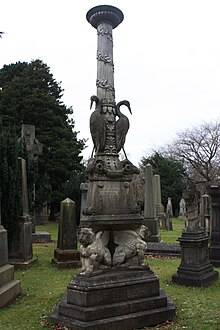
David Welsh FRSE was a Scottish divine and academic. He was Moderator of the General Assembly of the Church of Scotland in 1842. In the Disruption of 1843 he was one of the leading figures in the establishment of the Free Church of Scotland.
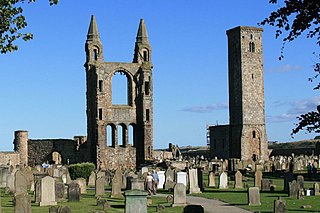
The Cathedral of St Andrew is a ruined cathedral in St Andrews, Fife, Scotland. It was built in 1158 and became the centre of the Medieval Catholic Church in Scotland as the seat of the Archdiocese of St Andrews and the Bishops and Archbishops of St Andrews. It fell into disuse and ruin after Catholic mass was outlawed during the 16th-century Scottish Reformation. It is currently a monument in the custody of Historic Environment Scotland. The ruins indicate that the building was approximately 119 m (390 ft) long, and is the largest church to have been built in Scotland.

The Grange is an affluent suburb of Edinburgh, just south of the city centre, with Morningside and Greenhill to the west, Newington to the east, The Meadows park and Marchmont to the north, and Blackford Hill to the south. It is a conservation area characterised by large early Victorian stone-built villas and mansions, often with very large gardens. The Grange was built mainly between 1830 and 1890, and the area represented the idealisation of country living within an urban setting.

Liberton is a suburb of Edinburgh, the capital of Scotland. It is in the south of the city, south of The Inch, east of the Braid Hills and west of Moredun.

The Parish Church of St Cuthbert is a parish church of the Church of Scotland in central Edinburgh. Probably founded in the 7th century, the church once covered an extensive parish around the burgh of Edinburgh. The church's current building was designed by Hippolyte Blanc and completed in 1894.

Colinton Parish Church is a congregation of the Church of Scotland. The church building is located in Dell Road, Colinton, Edinburgh, Scotland next to the Water of Leith.

Charles John Guthrie, Lord Guthrie FRSE FRSGS LLD was a Scottish judge and lawyer.

The Canongate Kirkyard stands around Canongate Kirk on the Royal Mile in Edinburgh, Scotland. The churchyard was used for burials from the late 1680s until the mid-20th century.

Greyfriars Kirkyard is the graveyard surrounding Greyfriars Kirk in Edinburgh, Scotland. It is located at the southern edge of the Old Town, adjacent to George Heriot's School. Burials have been taking place since the late 16th century, and a number of notable Edinburgh residents are interred at Greyfriars. The Kirkyard is operated by City of Edinburgh Council in liaison with a charitable trust, which is linked to but separate from the church. The Kirkyard and its monuments are protected as a category A listed building.
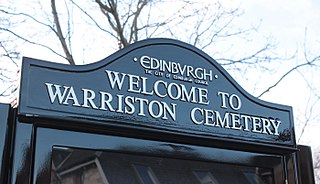
Warriston Cemetery is a cemetery in Edinburgh. It lies in Warriston, one of the northern suburbs of Edinburgh, Scotland. It was built by the then newly-formed Edinburgh Cemetery Company, and occupies around 14 acres (5.7 ha) of land on a slightly sloping site. It contains many tens of thousands of graves, including notable Victorian and Edwardian figures, the most eminent being the physician Sir James Young Simpson.

Rosebank Cemetery is a 19th-century cemetery in Edinburgh, Scotland, at the junction of Pilrig Street and Broughton Road in the Pilrig area, close to the historical boundary of Leith. The cemetery is protected as a category C listed building.

John Hutchison was a Scottish sculptor based in Edinburgh. He was the son of an unnamed builder, and his artistic life began as a thirteen-year-old woodcarving apprentice. He attended art school in the evenings, then later became a student at the Trustees Academy. and attracted the patronage of its owner, Patrick Allan Fraser, who gave him commissions to fund his study in Rome. Although after Rome he continued to enjoy ancient Roman sculptural themes, he remained in Edinburgh for the rest of his life, working in wood, clay and marble, and concentrating on portraiture of Scottish people, and images of Scottish myth and history. He created the bust of Sir Walter Scott in Poets' Corner in Westminster Abbey. He was a successful artist who received commissions from Queen Victoria.

New Calton Burial Ground is a burial ground in Edinburgh. It was built as an overspill and functional replacement to Old Calton Burial Ground and lies half a mile to its east on Regent Road in Edinburgh, Scotland, on the south-east slopes of Calton Hill. On its southern edge it attaches to the north-east edge of the Canongate in the Old Town. It lies on a fairly steep south-facing slope with views to Holyrood Palace, the Scottish Parliament Building and Arthur’s Seat.

Newington Cemetery is a cemetery in Edinburgh, Scotland. Technically it lies beyond Newington itself, standing on an awkward elongated kite-shaped site between a railway line and Dalkeith Road, between Prestonfield and Peffermill.

Morningside Cemetery is a cemetery in south Edinburgh. It was established in 1878 by the Metropolitan Cemetery Company, originally just outwith the then city boundary, the nearest suburb then being Morningside. It extends to just over 13 acres in area. The cemetery contains 81 war graves. Although arguably visually uninspiring the cemetery contains the graves of several important female figures; including a female air commandant, Scotland's first female surgeon, the first female Fellow of the Royal College of Physicians of Edinburgh, a Nobel Prize winner and many church missionaries.
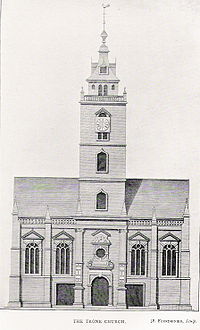
John Drysdale FRSE was twice Moderator of the General Assembly of the Church of Scotland, both in 1773 and in 1784. He was Dean of the Chapel Royal in Scotland 1766 to 1788, and Chaplain in Ordinary to George III. He was brother-in-law to Robert Adam and father-in-law to Andrew Dalzell.
Robert Hamilton FRSE was Professor of Divinity at the University of Edinburgh. He served twice as Moderator of the General Assembly of the Church of Scotland and was also a co-founder of the Royal Society of Edinburgh.
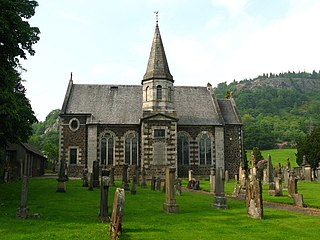
Logie Kirk, considered something of a ‘hidden gem, is nestled in a tranquil spot beneath Dumyat at the Western side of the Ochil Hills, east of Stirling in central Scotland. It serves Church of Scotland pastoral duties in the areas of Cambuskenneth, Bridge of Allan, Causewayhead, and formerly the estate of Airthrey Castle.

The Western Cemetery in Dundee, Scotland, is a still-operational cemetery founded in the mid 19th century. It rises northwards from the Perth Road, with terraces in its upper sections. It views over the Firth of Tay to the Tay Rail Bridge and Fife. The Western Cemetery is maintained and managed by Dundee City Council.





